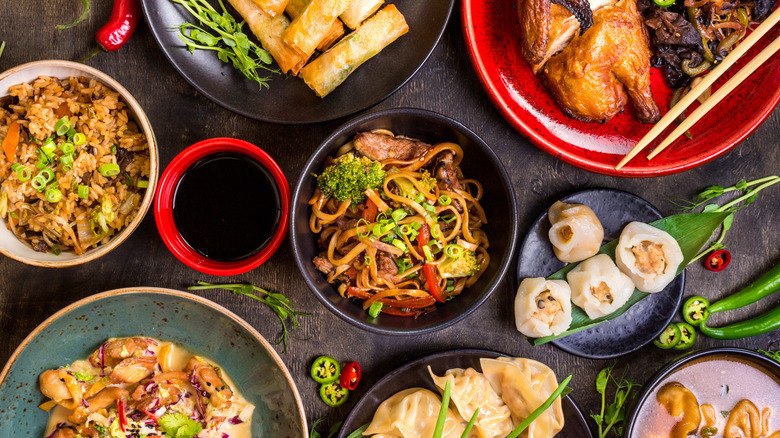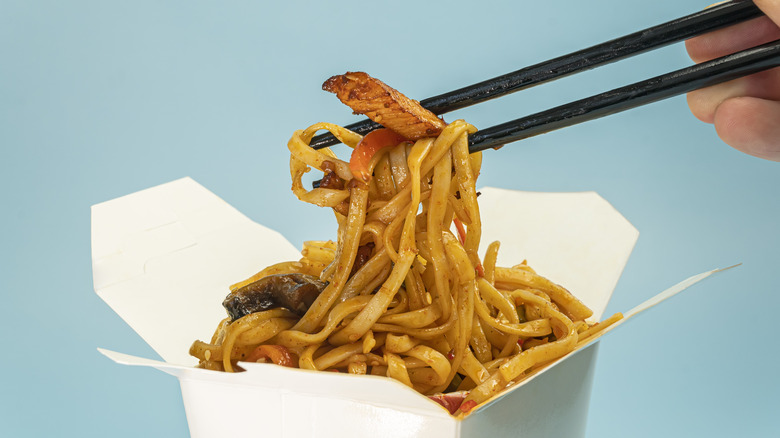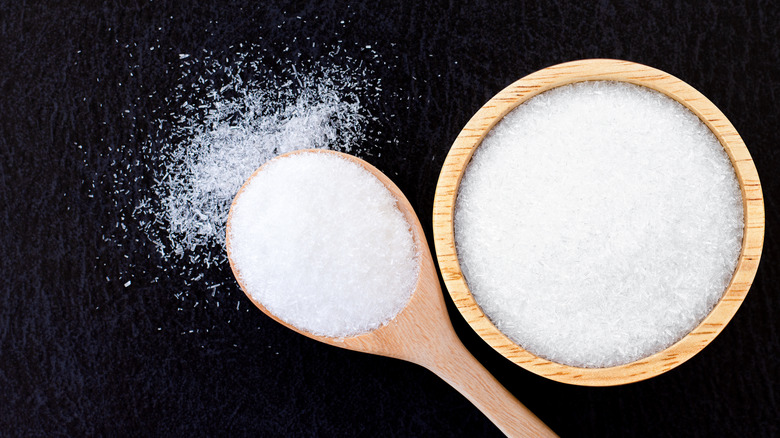The Longstanding Myth About Chinese Food You Shouldn't Believe
It might be hard to believe, but just around 50 years ago, most Americans had never tried Chinese food. A few Chinese restaurants popped up in California around the time of the Gold Rush, but the spread of Chinese food in the U.S. was quickly halted by the Chinese Exclusion Act, which banned Chinese workers from entering the country from 1882 until its repeal in 1943. Although the early 1900s had seen the rise of chop suey joints, it really wasn't until the '60s and '70s that Americans got to experience truly authentic Chinese food. Cantonese dim sum, Szechuan hotpot, and Beijing roast duck became beloved classics, but then, fear struck.
In 1968, a doctor named Robert Ho Man Kwok wrote a letter to the editor of the New England Journal of Medicine in which he described feeling numbness at the back of his neck, heart palpitations, and a general feeling of weakness whenever he ate at Chinese restaurants. He theorized that these symptoms could be caused by monosodium glutamate, better known as MSG, which is a common ingredient in Chinese cooking. This letter ignited a panic that gripped Americans even to this day. The masses were convinced that MSG was dangerous. Customers began demanding Chinese restaurants withhold it from their food or simply avoided Chinese food altogether. But this fear was woefully misguided. MSG is perfectly safe to eat, and uncovering the truth behind this myth means facing the dark reality of xenophobia.
How the MSG panic began
Robert Ho Man Kwok's letter was strictly speculative and did not offer a scientific basis for his hypothesis. Nevertheless, a month after his letter was published, 10 more doctors wrote to the New England Journal of Medicine, describing their own experiences with "Chinese Restaurant Syndrome." These letters were highly inconsistent, with each one listing a different set of symptoms from sweats to fainting. While Kwok's letter had specifically cited Northern Chinese food as the source of his trouble, subsequent letters did not make any such distinction. Furthermore, Kwok was originally from China, where MSG is a common ingredient, but said he only started getting sick after eating at American Chinese restaurants.
Another glaring issue in these letters was the fact that each doctor had a different hypothesis for what caused their symptoms. They cited ingredients as disparate as frozen vegetables, mustard, and pufferfish venom. However, one doctor wrote that it could not be MSG at fault, as he cooked with it often himself and never felt any ill effects.
Despite the inconsistencies in the initial reports, multiple studies were done in the '60s and '70s to investigate the effects of MSG. These seemingly confirmed that MSG had a harmful impact, but closer analysis reveals that this research was deeply flawed. Studies were not done blind, with participants knowing when they were given MSG, and in some studies, participants were injected with MSG or fed massive quantities on an empty stomach. This is a fundamentally unrealistic representation of actual MSG consumption.
The truth about Chinese Restaurant Syndrome
It is possible to have an MSG sensitivity (similar to gluten sensitivity), which can cause digestive issues, but this affects a very small portion of the population and typically only manifests when extremely large quantities of MG are consumed on an empty stomach. Adverse reactions may also be due to histamine intolerance, which causes the same symptoms described by Dr. Robert Ho Man Kwok and others. Histamine is present in many foods, including soy sauce, which contains high levels of the chemical.
In most cases, "Chinese Restaurant Syndrome" is likely due to the nocebo effect. The flip side of the placebo effect, the nocebo effect occurs when someone is given a substance that they are told has negative effects and subsequently report feeling those exact effects. If somebody enters a situation with pre-existing biases, they will naturally look to confirm them.
Some of these biases are rooted in racism towards Asians in the U.S. When "Chinese Restaurant Syndrome" was first reported, it had barely been two decades since the Chinese Exclusion Act was repealed. Reporting on MSG was alarmist; The Chicago Tribune ran an article titled "Chinese Food Make You Crazy?" that was riddled with offensive language. The most telling fact in this matter is that Americans had been eating MSG for decades without any complaints, and it was only when it was attached to Chinese food that people started complaining. In actuality, many American foods contain MSG, and whether you know it or not, you're likely eating it every day.
What is MSG?
MSG was first created in 1908 by Japanese chemist Kikunae Ikeda. He wanted to find out why dashi, a kelp-based stock for Japanese soups, was so delicious. He determined that the flavor he loved was due to a certain amino acid in the kelp called glutamate. Ikeda wanted to turn glutamate into a seasoning so it could be added to any food, so he combined it with sodium to create a crystalline powder: monosodium glutamate. Ikune also came up with a name for the unique flavor of glutamate. He called it "umami" after the Japanese "umai," meaning "delicious." In essence, MSG is to umami what salt is to saltiness.
Glutamate is found in a vast number of foods. It's in tomatoes, mushrooms, and aged cheeses like parmesan. It's especially prevalent in processed foods and fast food, like frozen pizza, KFC chicken, and Doritos. It's even in human breast milk. In fact, glutamate plays an important role in the human body, being the main excitatory neurotransmitter, even more abundant than epinephrine and norepinephrine. There's glutamate surging through our nervous systems and MSG is in countless things we eat, and yet, people only seem to complain when it's in Chinese food. The bias is hard to ignore.



